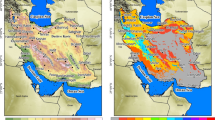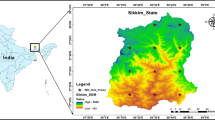Abstract
Asymmetrical monsoons during the recent past have resulted into spatially variable and devastating floods in South Asia. Analysis of historic precipitation extremes record may help in formulating mitigation strategies at local level. Eleven indices of precipitation extremes were evaluated using RClimDex and daily time series data for analysis period of 1981–2010 from five representative cities across Punjab province of Pakistan. The indices include consecutive dry days, consecutive wet days, number of days above daily average precipitation, number of days with precipitation ≥10 mm, number of days with precipitation ≥20 mm, very wet days, extremely wet days, simple daily intensity index, maximum 1-day precipitation quantity, maximum 5 consecutive day precipitation quantity, and annual total wet-day precipitation. Mann-Kendall test and Sen’s slope extremes were used to detect trends in indices. Droughts and excessive precipitation were dictated by elevation from mean sea level with prolonged dry spells in southern Punjab and vice versa confirming spatial trends for precipitation extremes. However, no temporal trend was observed for any of the indices. Summer in the region is the wettest season depicting contribution of monsoons during June through August toward devastating floods in the region.





Similar content being viewed by others
References
Abbas F (2013) Analysis of a historical (1981–2010) temperature record of Punjab province of Pakistan. Earth Interact. doi:10.1175/2013EI000528.1
Aguilar E, Peterson TC, Obando PR, Frutos R, Retana JA, Solera M, Soley J, Garcia IG, Araujo RM, Santos AR, Valle VE, Brunet M, Aguilar L, Alvarez LA, Bautista M, Castanon C, Herrera L, Ruano E, Sinay JJ, Sanchez E, Oviedo GIH, Obed F, Salgado JE, Vazquez JL, Baca M, Gutierrez M, Centella C, Espinosa J, Martinez D, Olmedo B, Espinoza CEO, Nunez R, Haylock M, Benavides H, Mayorga R (2005) Changes in precipitation and temperature extremes in Central America and northern South America, 1961–2003. J Geophys Res 110:1–15
Alexander LV, Zhang X, Peterson TC, Caesar J, Gleason B, Klein Tank AMG, Haylock M, Collins D, Trewin B, Rahimzadeh F, Tagipour A, Ambenje P, Rupa-Kumar K, Revadekar J, Griffiths G (2006) Global observed changes in daily climate extremes of temperature and precipitation. J Geophys Res 111:D05109. doi:10.1029/2005JD006290
Annamalai H, Jan Hafner K, Sooraj P, Pillai P (2013) Global warming shifts the monsoon circulation, drying South Asia. J Clim 26:2701–2718
Basit A, Shoaib SR, Irfan N, Avila R (2012) Simulation of monsoon precipitation over South-Asia using RegCM3. ISRN Meteorology 12:754902. doi:10.5402/2012/754902
Chu P, Chen YR, Schroeder TA (2010) Changes in precipitation extremes in the Hawaiian Islands in a warming climate. J Clim 23:4881–4900
Easterling DR, Horton B, Jones PD, Peterson TC, Karl TR, Parker DE, Salinger MJ, Razuvayev V, Plummer N, Jamason P, Folland CK (1997) Maximum and minimum temperature trends for the globe. Science 277:364–367
Easterling DR, Evans JL, Groisman PY, Karl TR, Kunkel KE, Ambenje P (2000) Observed variability and trends in extreme climate events: a brief review. Bull Am Meteorol Soc 81:417–425
FMI (2002) Detecting Trends of Annual Values of Atmospheric Pollutants by the Mann–Kendall Test and Sen’s Slope Estimates: The Excel Template Application MAKESENS. Finnish Meteorological Institute, 2002
Frich P, Alexander LV, Della-Marta P, Gleason B, Haylock M, Klein Tank AMG, Peterson T (2002) Observed coherent changes in climatic extremes during the second half of the twentieth century. Clim Res 19:193–212
Gilbert RO (1987) Statistical methods for environmental pollution monitoring. Van Nostrand Reinhold, New York
Griffiths ML, Bradley RS (2007) Variations of twentieth century temperature and precipitation extreme indicators in the northeast United States. J Clim 20:5401–5417
Hansen J, Ruedy R, Sato M, Imhoff M, Lawrence W, Easterling D, Peterson T, Karl T (2001) A closer look at United States and global surface temperature change. J Geophys Res 106:23947–23963
Huang B, Nobel PS (1992) Hydraulic conductivity and anatomy of lateral roots of Agave deserti during root growth and drought induced abscission. J Exp Bot 43:1441–1449
Jones PD, Moberg A (2003) Hemispheric and large-scale surface air temperature variations: an extensive revision and an update to 2001. J Clim 16:206–223
Karl TR, Easterling DR (1999) Climate extremes: selected review and future research directions. Climate Change 42:309–325
Karl TR, Knight RW (1998) Secular trends of precipitation amount, frequency, and intensity in the United States. Bull Am Meteorol Soc 79:1107–1119
Kendall MG (1955) Rank correlation methods. Griffin, London
Kruger AC (2006) Observed trends in daily precipitation indices in South Africa: 1910–2004. Int J Climatol 26(15):2275–2285
Klein Tank AMG, Konnen GP (2003) Trends in indices of daily temperature and precipitation extremes in Europe, 1946–99. J Clim 16:3665–3680
Landsea CW (1993) A climatology of intense (or major) Atlantic hurricanes. Mon Weather Rev 121:1703–1713
Mann HB (1945) Nonparametric test against trend. Econometrica 13:245–259
Moberg A, Jones PD (2005) Trends in indices for extremes in daily temperature and precipitation in central and western Europe, 1901-99. Int J Climatol 25:1149–1171
Neumann CJ, Jarvinen BR, Pike AC, Elms JD (1987) Tropical Cyclones of the North Atlantic Ocean, 1871–1986. Natl, Environ. Satell. Data and Inf. Serv., p 186
New M, Todd M, Hulme M, Jones P (2001) Precipitation measurements and trends in the twentieth century. Int J Climatol 21:1889–1922
Peterson TC, Taylor MA, Demeritte R, Duncombe DL, Burton S, Thompson F, Porter A, Mercedes M, Villegas E, Fils RS, Klein Tank A, Martis A, Warner R, Joyette A, Mills W, Alexander L, Gleason B (2002) Recent changes in climate extremes in the Caribbean region. J Geophys Res 107:1–9
Peterson TC, Vose RS (1997) An overview of the Global Historical Climatology Network temperature database. Bull Am Meteorol Soc 78:2837–2849
Qian WH, Zhu YF, Tang SQ (2011) Reconstructed index of summer monsoon dry–wet modes in East Asia for the last millennium. Chin Sci Bull 56:3019–3027
Roy SS, Balling RC Jr (2004) Trends in extreme daily precipitation indices in India. Int J Climatol 24:457–466
Safeeq M, Mair A, Fares A (2012) Temporal and spatial trends in air temperature on the Island of Oahu, Hawaii. Int J Climatol. doi:10.1002/joc.3629
Salmi T, Maatta A, Anttila P, Ruoho-Airola T, Amnell T (2002) Publications on air quality. No 31. Detecting trends of annual values of atmospheric pollutants by the Mann-Kendall test and Sen’s slope estimates. Finnish Meteorological Institute Helsinki, Finland
Sen PK (1968) Estimates of the regression coefficient based on Kendall's tau. J Am Stat Assoc 63:1379–1389
Tebaldi C, Hayhoe K, Arblaster JM, Meehl GA (2006) Going to the extremes: an intercomparison of model-simulated historical and future changes in extreme events. Climate Change 79:185–211
Zhai P, Sun A, Ren F, Liu X, Gao B, Zhang Q (1999) Changes of climate extremes in China. Climate Change 42:203–218
Zhang X, Yang F (2004) RClimDex (1.0) User Guide: Climate Research Branch Environment Canada (2004)
Zhang X, Hegerl G, Zwiers FW, Kenyon J (2005) Avoiding inhomogeneity in percentile-based indices of temperature extremes. J Clim 18:1641–1651
Acknowledgments
Funds for this research were provided by the Higher Commission of Pakistan.
Author information
Authors and Affiliations
Corresponding author
Rights and permissions
About this article
Cite this article
Abbas, F., Ahmad, A., Safeeq, M. et al. Changes in precipitation extremes over arid to semiarid and subhumid Punjab, Pakistan. Theor Appl Climatol 116, 671–680 (2014). https://doi.org/10.1007/s00704-013-0988-8
Received:
Accepted:
Published:
Issue Date:
DOI: https://doi.org/10.1007/s00704-013-0988-8




